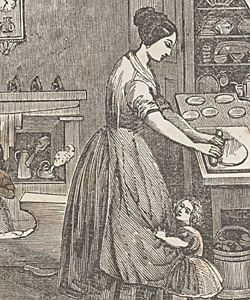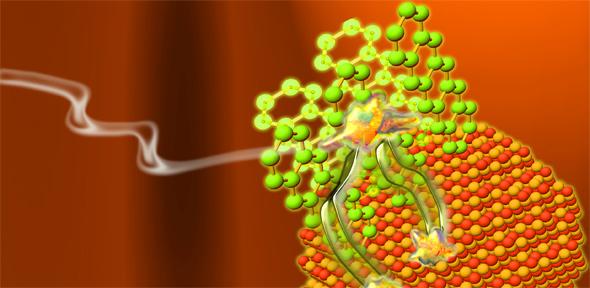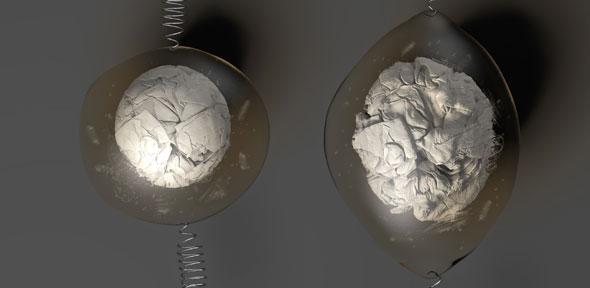More than 10 million of us are watching it and we’ve bought the recipe books: once again Great British Bake Off has taken the nation by storm with the high drama of pastry, pies and profiteroles. But how many of us keep our households supplied with home-made bread and cakes, let alone have the skills to rustle up a perfect gooseberry tart or a faultless chocolate roulade?
In his book Cottage Economy, first published in 1821, the reforming journalist William Cobbett laments the decline in baking. “As to the act of making bread, it would be shocking indeed if that had to be taught by means of books. Every woman high or low, ought to know how to make bread. If she does not, she is unworthy of trust and confidence: and indeed a mere burden on the community. Yet it is but too true, that many women, even those who get their living from their labour, know nothing of the making of bread.”
Cobbett’ was a farmer as well as a writer. His purpose in writing Cottage Economy was to promote self-sufficiency in the rural labouring classes. Elsewhere in the book, he counsels readers to ensure that their daughters learn to bake in order to command a better wage as servants. “’Can she bake?’ is the question that I always put. If she can then she is worth a pound or two a year more.”
Sophie McGeevor, a PhD candidate in the Faculty of History, is studying women’s work in mid-19th century England as part of a major longitudinal study of employment. In particular, McGeevor looks at the use of time, building a picture of the ways in which women divided their waking hours between paid and unpaid work as they carried out essential but often overlooked household tasks such as laundry, caring, mending and cooking. ![]()
She says: “What interests me about Cobbett’s writing is that in advocating self-sufficiency, he was calling for a way of life which was both home-based and incredibly time intensive – and which was, in many ways, incompatible with remunerative work available to women in this period.”
Home baking was central to the kind of wholesome and resourceful domesticity that Cobbett promoted. It was an activity far removed from today’s image of baking as a fun and fulfilling hobby – and it was undertaken almost exclusively by women. McGeevor’s research into a collection of autobiographies held by the British Library shows that many households baked just once a week when the oven would be lit especially for the purpose.
A batch of loaves that was fresh out of the oven on a Wednesday would be eaten stale by the following Tuesday. Heating an oven to exactly the right temperature for baking, and juggling the baking of various products, was an art. For many families, burnt or undercooked goods would be a disastrous waste of precious resources – ingredients, fuel and time - not simply a question of a petulant Bake Off binning.
An autobiography written by Louise Jermy, who was born in 1877, illustrates just what an undertaking ‘baking day’ was for households adhering to what were already old-fashioned traditions. Sent from London to the country to recover from an illness, Louise describes her Aunt Anne baking once a fortnight, producing rabbit and hare pies, fruit tarts and batch cakes, as well as bread. All these are cooked in a brick oven heated by “three large faggots of thorns” … “when the oven is white hot it was scrapped out, and then mopped to clean the ashes and the door was fastened”.
Notes made by Louise show the times involved in baking various items: batch cakes 1 ½ hrs; buns “about a quarter”; “sweet cakes and pies about one and a half to two hours”; “the large loaves were left for two and a half hours”. Such was the hard work and time involved in this task that Aunt Ann has made a neat arrangement with her daughter-in-law. The two women bake on alternate weeks “whichever one baked would make a good supply of batch cakes, each sending fresh ones, exchanging every week so that we had some fresh bread”.
A stove was not just expensive to heat but, in summer especially, it made a small house uncomfortably hot. Nellie Hoare, born in 1898, remembers: “There was a bakery not far from us and often I have taken a dough-cake Mother had made or a bread pudding and they would bake it. They would do this for anyone if it was taken in before nine in the morning and it could be fetched about three hours later for the price of one penny. People used to take more things to bake in the summer time as no-one wanted to keep up the fire enough for baking at home then. Of course we had to keep some sort of fire going at home winter and summer as we had nothing else to boil a kettle or do any cooking.”![]()
It’s notable that at the end of the 19th century Louise’s aunt is making cakes and Nellie’s mother is sending her out with puddings to cook. Widespread evidence for working class consumption of baked sugary cakes and puddings cannot be found until the 15th century and they remained luxury items well into the 1800s.
“Though labouring people had begun to consume sugar in increasing quantities over the course of the 18th century, it was generally eked out in weak tea and not used in everyday baking. It was not until the mid-19th century, with the push for free trade and the abolition of preferential duties for British Colonies beginning with the Sugar Duties Act of 1846, that a huge fall in the price of sugar made the eating and baking of cakes and biscuits more affordable,” said McGeevor.
“Today home bread-making is chiefly a matter of choice and privilege. It’s something people do as a leisure activity using a bread maker or a modern oven which heats up in minutes. In the 19th century, bread was the mainstay of the English diet, eaten several times a day, and baking was a heavy and laborious process.”
A common misconception, however, is that all women made bread for their families. Women who worked outside the home would not have been able to spend a whole day baking. Families who lived in areas where fuel was expensive showed a preference for buying ready-made bread.
Another big factor in the mix was fuel. Baking in an oven required substantial quantities of wood and/or coal. Coal was cheap in areas close to coal fields but more expensive the further it had to be transported. So that even William Cobbett admitted that for families in London making their own bread might be uneconomic. ![]()
In the 1870s, a French engineer called Frederic Le Play made a detailed study of the daily life of more than 60 labouring families. Four of these families were English. Comparing the household budgets of two cutlers with similar sized households – one in London and the other in Sheffield – he showed that the Sheffield family consumed 6,150 kg of coal against the London family’s 4,064 kg, reflecting the cheaper prices of the north.
“The disparity in coal prices may explain why the family in Sheffield made their own bread while the London family brought their bread from a baker,” said McGeevor. “The Sheffield cutler, his wife and three children consumed 1,272 lbs of flour per year which equates to at least three 2lb loaves each day, all baked by the cutler’s wife. This level of consumption seems staggeringly high to us but it fits with other evidence we have of per capita consumption of bread.”
Regional cookery is shaped not just by availability of ingredients but also by the source of heat available to cook food on or in – and by the time that can be devoted to the task. “Many regional specialities originate from baking not in an oven but on an open fire. In peat-burning areas, bread and pies could be baked in cast-iron pots, known as Dutch ovens, which were placed in the ashes,” said McGeevor.
“Oatcakes, griddle cakes, Welsh cakes and drop scones – as well as delicious pancake-like cakes still available in Derbyshire and Staffordshire – were cooked on a cast-iron griddle or bake-stones heated by an open fire. All these items are much quicker and less laborious to cook than bread – and they are cheap, tasty and filling.”
The Bake Off phenomenon draws heavily on a brand of cakes-as-comfort-food nostalgia that has little to do with reality. “Many of us have embraced home-baking as a result of the show and some of us are encouraged by memories of our grandmothers’ creations. We would, however, be mistaken to assume that home baking was part of women's lives for several generations before,” said McGeevor.
“Women’s work has always been constrained by time and resources. How many of us would be enthusiastic about baking if we had first to light the oven with a pile of sticks and didn’t have the option of popping into a supermarket if it all goes wrong?”
Inset images: image from household guide (Smithsonian Libraries); oven featured in Cassell's Household Guide (Wikia); medieval baker (Wikipedia)




 Meanwhile, Robin Franklin’s team has shown that it’s possible to kick-start OPCs, driving the formation of oligodendrocytes and sheath formation, using a drug that targets retinoid X receptor-gamma, a molecule found within OPCs. The results are positive and clinical trials will shortly commence in collaboration with Dr Alasdair Coles from the Department of Clinical Neurosciences and the MRC Centre for Regenerative Medicine at the University of Edinburgh.
Meanwhile, Robin Franklin’s team has shown that it’s possible to kick-start OPCs, driving the formation of oligodendrocytes and sheath formation, using a drug that targets retinoid X receptor-gamma, a molecule found within OPCs. The results are positive and clinical trials will shortly commence in collaboration with Dr Alasdair Coles from the Department of Clinical Neurosciences and the MRC Centre for Regenerative Medicine at the University of Edinburgh.






















